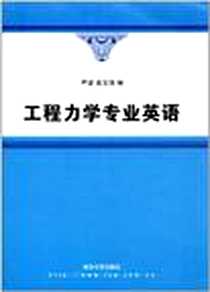《工程力学专业英语》
《工程力学专业英语》
出版时间:2012-8
出版社:清华大学出版社
作者:严波 等编
页数:251
字数:390000
《工程力学专业英语》内容概要[E]
《工程力学专业英语》选编了工程力学专业涉及的科技英文文章,包括理论力学、材料力学、弹性力学、结构力学、振动力学、塑性力学、实验力学、计算力学、疲劳与断裂、复合材料力学和流体力学等内容,并注意纳入相应课程的新概念,覆盖面广。本书还分单元介绍了英文科技报告、学位论文、期刊论文写作技巧和英汉科技文章的翻译技巧,旨在培养学生科技论文写作和翻译的基本技能。各单元课文正文适用于教师精讲,第一篇阅读材料适用于本科生自学,或在教师指导下学习,第二篇阅读材料内容相对较深,主要适用于研究生学习参考。此外,每篇文章后面均列出了生词和短语,附录中列出了常用专业词汇和短语,便于读者查阅。
《工程力学专业英语》无论是在内容选材还是在内容编写上均具有特色,是一本适用于工程力学专业和力学类专业本科生的实用教材,也可供土木、机械、材料等相关工科专业的本科生、研究生及相关工程技术人员学习参考。
《工程力学专业英语》书籍目录[E]
目录回到顶部↑《工程力学专业英语》
unit onesome basic concepts of mechanics
writing skill of experimental research report: introduction
(1)
reading material (1): kinetic energy and work
reading material (2): the lagrangian method
unit twothe flexure formula of beams
writing skill of experimental research report: introduction
(2)
reading material (1): metals in mechanical and structural
design
reading material (2): stability of column
unit threewhat is continuum mechanics
writing skill of experimental research report: introduction
(3)
reading material (1): stress
reading material (2): solid mechanics
unit fourhooke’s law
writing skill of experimental research report: method and
materials
reading material (1): basic equations of elastic homogeneous and
isotropic bodies
reading material (2): stress waves in solids
unit fivestatically indeterminate structure
writing skill of experimental research report: results and
discussion
reading material (1): basic structural elements
.reading material (2): general theory of plane trusses
unit sixfree vibrations: one degree of freedom
writing skill of experimental research report: abstract
reading material (1): forced harmonic vibration
reading material (2): response to arbitrary, step, and pulse
excitations
unit sevendescription of elastoplastic material response under
uniaxial case
科技英语翻译技巧: 科技文章的特点
reading material (1): yield criteria of metals
reading material (2): some plasticity and viscoplasticity
constitutive theories
unit eightexperimental stress analysis
科技英语翻译技巧: 词义引申和词量增减
reading material (1): strain gage system
reading material (2): perspectives in experimental solid
mechanics
unit ninedirect formulation of finite element characteristics
科技英语翻译技巧: 词性的转换和句子成分转换
reading material (1): variational principle
reading material (2): generalization of the finite element
concepts
unit tenfatigue of materials
科技英语翻译技巧: 常见多功能词的译法
reading material (1): linear fracture mechanics
reading material (2): fracture mechanics
unit elevenbasic terminology of laminated fiber?reinforced
composite materials
科技英语翻译技巧: 数词的译法和被动语态的译法
reading material (1): macromechanical behavior of a lamina
reading material (2): shape memory alloy and smart hybrid
composites
advanced materials for the 21st century
unit twelvefluid mechanics
科技英语翻译技巧: 定语从句及同位语从句的译法
reading material (1): constitutive equations of fluids
reading material (2): finite difference method
unit thirteenrock mechanics
科技英语翻译技巧: 状语从句的译法
reading material (1): special stress?strain states of rock
reading material (2): soil mechanics
unit fourteenstructural optimization
科技英语翻译技巧: 长句的译法
reading material (1): research directions in computational
mechanics
reading material (2): new directions in mechanics
附录: 常用专业词汇和用语汇总表
参考文献
《工程力学专业英语》章节摘录[E]
Tension.Tension is the general name for a force that a rope,stick,etc. ,exerts when it is pulled on.Every piece of the rope feels a tension force in both directions,except the end point,which feels a tension on one side and a force on the other side from whatever object is attached to the end.
In some cases,the tension may vary along the rope. The“Rope wrapped around a pole”example is a good illustration of this.In other cases,the tension must be the same everywhere.For example,in a hanging massless rope,or in a massless rope hanging over a frictionless pulley,the tension must be the same at all points, because otherwise there would be a net force on at least one tiny piece,and then F=ma would yield an infinite acceleration for this tiny piece. Normal force. This is the force perpendicular to a surface that the the surface appliesto an object. The total force applied by a surface is usually a combination of the normal force and the fric.tion force. But for frictionless surface such as greasy ones or ice,only the normal force exists. The normal force comes about because the surface actually compressesa tiny bit and acts like a very rigid spring. The surface gets squashed until the restoringforce equals the force the object applies.
Remarks: For the most part,the only difference between a “tension”and a“normalforce”is the direction of the force. Both situations can be modeled by a spring., In the caseof a tension,the spring (a rope,a stick,or whatever)is stretched,and the force on thegiven object is directed toward the spring.In the case of normal force,the spring is compressed,and the force on the given object is directed away from the spring.Things likesticks can provide both normal forces and tension. But a rope,for example,has a hard timeproviding a normal force.
In practice,in the case of elongated objects such as stick,a compressive force is usuallycalled a6'compressive tension,or a negative tension,instead of a normal force.So bythese definitions,a tension can point either way. At any rate,it's just semantics. If youuse any of these descriptions for a compressed stick,people will know what you mean.
Friction. Friction is the force parallel to a surface that a surface applies to an object.Some surfaces,such as sandpaper,have a great deal of friction. Some,such as greasy ones,have essentially no friction. There are two types of friction,called 66kinetic" friction and“static”friction.
Kinetic friction deals with two objects moving relative to each other.It is usually agood approximation to say that the kinetic friction between two objects is proportional tothe normal force between them. The constant of proportionality is called flk (the“coefficient of kinetic friction”),where pkdepends on the two surfaces involved.Thus,F=UkN,where N is the normal force. The direction of the force is opposite to the motion.
Static friction deals with two objects at rest relative to each other. In the static case,we have F≤usN (where ,us is the “coefficient of static frictio”).Note the inequality sign.
……